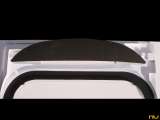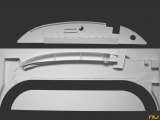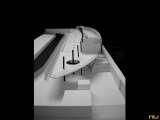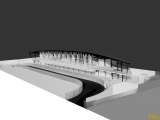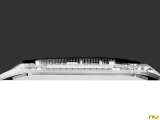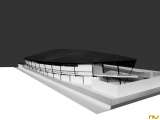|
The Meridiana Dog Track was built between 1961 and 1964 on a plot of land very close to Meridiana Avenue in the north of Barcelona. This zone had begun to be urbanised after the construction of the 1951 Eucharistic Congress homes, a process which was extended in other publicly-subsidised housing developments that ended up framing the building designed by Antonio Bonet and Josep Puig Torné, and brilliantly photographed by Català Roca in the 1960s.
The general shape of the building is heavily conditioned by the structural solution that determines the presence of three floating figures: the parabolic sheeting of the roof, the vertical striation of the brise-soleils, and the bleachers and terrace. The surface of the roof is based on straight lines which are supported by another line on either end: one is shaped like a parabola from above (over the external facade facing Riera de Horta Street) while the other is parabola-shaped from the side (the inside facade). These two lines of differing lengths (107 metres over the line parallel to the track), are divided into equal parts which together define the alignment of the bays. The main structure is laid out following these radial arcs, made up of 18 metallic beams with varying thickness and lengths tilted towards the street along the same angle and supported atop a single row of columns in the middle of the floor.
Any possible rocking is stabilised by tensors that secure the roof beams to the slab of the terrace on the outside and to the brise-soleils on the inside. Likewise, two metal stanchions help to brace and visually lighten the ends of the terraces and roof. The historical reference to this ingenious solution is the Zarzuela racetrack designed by Arniches, Dominguez and Torroja in 1941. Perpendicular to the main structure, open-web triangular straps are laid out, made up of four round ones (two above and two below) connected by a light zigzag buttress. The slabs are made of concrete, the bleachers of prefabricated concrete and the roof plane is resolved with self-supporting chipboard (Viroterm) with asphalt roofing finished with aggregate.
The ground floor is set aside for the services, dog pens, restrooms, offices, the box office and a restaurant adjacent to the staircase next to the paddock area, from which the greyhounds can be glimpsed at rest. The betting zone and bar that frames views of Riera de Horta Street are located on the covered esplanade on the upper storey which wraps around the terrace and bleachers like a huge concavity boasting outstanding views of the racetrack to the south. A mezzanine near the finish line houses the judges, the speaker, the timers, the controls and the photographer. The finishes are extremely rough, metalwork with laminated profiles in a lead grey colour, unstained plywood panels, white grainy plaster and glazed ceramics in brownish and amber tones. Bonet’s approach to ‘less is more’.
Fernando Alvarez Prozorovich
|

